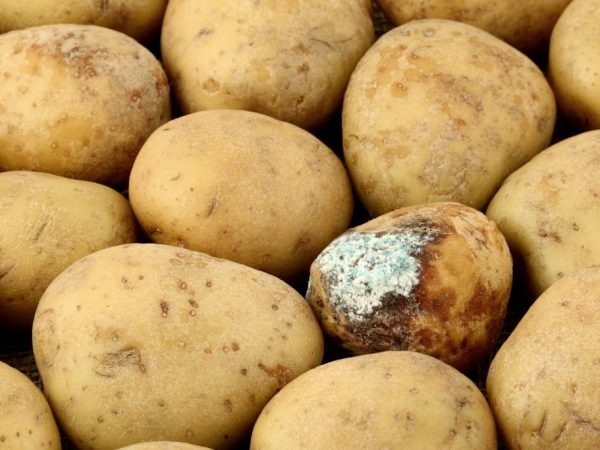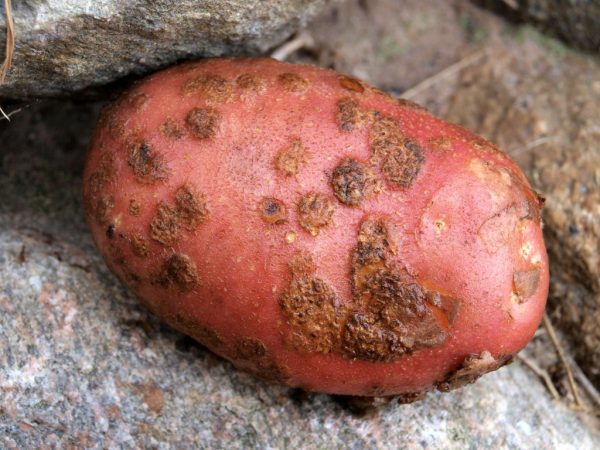Potato diseases and methods of dealing with them
Potatoes are the most common vegetable in our region, despite their cadmium content. Therefore, everyone who has at least a small piece of land is engaged in its cultivation. Unfortunately, there are very few varieties resistant to diseases. Therefore, it is necessary to be able to timely prevent the spread of a disease, and, if possible, cure damaged bushes. Let's consider what potato diseases are most common in our region. We will also talk about the methods of their treatment and preventive measures.

Potato diseases and methods of dealing with them
Late blight
Late blight is caused by a fungus Accordingly, this is a fungal disease of potatoes. It occurs most often, which is why we consider it first. If you do not take up the treatment of late blight in a timely manner, then the yield losses will be about 60-80%.
Symptoms
Determining this potato disease is not difficult. Its symptoms are not similar to those of other diseases. At the beginning of the disease, wet spots appear on the leaf plate. The disease develops quickly, and brown spots replace wet ones. To make sure that the diagnosis is correct, you should look at the back of the sheet plate. With late blight, a white bloom appears along the perimeter of brown spots. Through this plaque, the potato disease spreads to healthy areas of the leaf. In parallel with damage to the aboveground part of the vegetable crop, the fungus infects the tubers. Hard spots of brown color appear on them.
Late blight develops very quickly. If the diseased bushes are not treated in a timely manner, then in 25-30 days the disease will spread to all the plants that are on the site. And, in addition to potatoes, the mushroom affects tomatoes, eggplants, peppers, buckwheat, strawberries and flowers.
Signs of late blight appear, as a rule, during the flowering period of a vegetable crop.
Treatment and prevention
It is a treatable potato disease. When the first symptoms of late blight are found, we remove the affected leaves of the plant. Then, we process all the bushes with a 1% Bordeaux mixture. An alternative option is drugs that are sold in specialized stores. But, before using chemicals, we study the instructions. Some of them cannot be used during flowering or shortly before harvest. But you can only use insecticides if you know exactly what problem you are facing.
The disease develops in conditions of high humidity. Therefore, when planting, the tubers should not be placed too close to each other. The wind should move freely between the lips. It is necessary to spill the vegetable crop in a timely manner and make sure that water does not stagnate in the soil.
Alternaria
Alternaria is another fungal disease.It also has a second name - dry spot of potatoes. Its causative agents are conidia. Unlike late blight, Alternaria manifests itself with a lack of moisture. In terms of damage, in the absence of measures to combat dry spotting, you can lose up to 30% of the crop.
Symptoms
Alternaria infects all parts of the potato, including tubers. The first symptom of this potato disease is brown spots. If you look closely at the spots that appear, you can see concentric circles. With the development of dry spotting, the spots increase, they can merge with each other. When most of the leaf plate is affected, the leaf dries up, and the spots spread to the stem and petioles.
As for the defeat of the tubers, dark brown spots appear on the peel, slightly depressed inward. As Alternaria develops, the diameter of the spots increases, the peel becomes wrinkled. The wrinkles are in the form of concentric circles. The pulp rots under the damaged skin. But not wet, but dry rot is formed.
Favorable conditions for the development of Alternaria are hot weather with frequent rains.
Treatment and prevention

Rotting can be prevented
The fungicide Bravo should be used to treat this potato disease. For spraying 1 hectare of area, you will need about 2.5 liters of the drug. In addition to this fungicide, you can use the preparations Mancoceb, Metamil, Poliram, Acrobat MC, Kuprikol.
Prevention of dry spotting involves the cultivation of potato varieties resistant to it (Ogonyok, Lina, Nevsky, Filatovsky, Resurs, Zarevo). Also, as a preventive measure, the drug should be treated with special biological agents (Baktofit or Integral, for example).
Most often, alternaria develops when growing a vegetable crop on soils that lack nitrogen and potassium, and phosphorus is in excess. Accordingly, through the introduction of fertilizers, the content of certain microelements in the soil should be adjusted.
Brown rot
This is a bacterial disease of the potato, which is common in many regions of Russia. It is terrible because it often proceeds without symptoms in the first generation. And when growing in the field of a vegetable crop from tubers affected by brown rot, the symptoms appear clearly.
Symptoms
First of all, let's make a reservation that the bushes affected by this potato disease lag behind in growth. If you look closely at the leaf plate of a potato, you can see thin brown stripes along the veins. The same stripes are present in the area of the root part of the tops. If you cut the tops in the area of the brown strip, then mucous discharge, painted in a grayish color, will appear. As the bacterial disease develops, the leaves turn yellow and curl, the bush withers.
The disease manifests itself, as a rule, during the flowering of a vegetable crop. It develops very quickly. The stem turns black and lies on the ground. This is due to rotting of the root part of the tops.
Treatment and prevention
The chemical preparations that exist today are ineffective. The most popular drug is TMTD.
As a preventive measure, planting material should be treated with Planriz. It is not necessary to leave the injured preparation on the landing. Through damaged areas, various infections can get inside. Be sure to decontaminate the land after harvesting and adhere to the norms of crop rotation.
Verticillary wilting

Fungal disease
Potato verticillus is a fungal disease of the potato. Vertilliasis is most common in the eastern regions of Russia.
Symptoms
First of all, some leaves are withered. In parallel with wilting, a yellow edging appears at the edges of the leaf plates.As verticillosis spreads, brown spots appear on the leaf plates of the potato, which are surrounded by a yellow border, the leaf itself is twisted into a tube. The whole plant gradually begins to wither. If untreated, the bush dries up.
It is also worth noting that growth slows down in diseased plants. The reason for this is the partial death of the root system. Looking closely at the tops, you can see thin dark brown stripes that are slightly depressed inward. Brown furrows are visible in the cut of the stem of the affected bush. They are formed as a result of filling the vessels of the plant with the causative agent of verticillosis.
In conditions of high humidity, white bloom appears on the affected stems and the back of the affected leaves, which has a dirty gray or pink tint.
Treatment and prevention
There are no chemical treatments for verticillosis. The infected plant is removed to the beds and burned. Together with the infected bush, the top layer of soil, which is overflowing with the causative agent of this disease, should be removed. We plant plants on infected soil that are resistant to verticillosis (yarrow, peas, carrots, celery, cabbage). All fruit trees are resistant to this disease.
An effective preventive measure of verticillium is observance of crop rotation and proper care of the vegetable crop (hilling, weeding, timely harvesting). Prevention also involves the cultivation of varieties resistant to verticillosis, which include Ermak and Lorkh.
Blackleg
Blackleg belongs to the list of bacterial potato diseases. In addition to potatoes, it affects cabbage. The bacterium that causes damage to the plant looks like a stick.
Symptoms
With this potato disease, the leaves first wither and turn yellow. First, those leaves that are in the lower tier are affected. As the disease spreads, all leaves turn yellow. In parallel with the yellowing of the leaves, rotting of the stems occurs. The tops begin to rot at the base.
The defeat of tubers with a black leg does not occur immediately. After the stems have begun to rot, the tubers soften. In the cut of the tuber, it can be seen that the core rots and turns black. At first, it takes on a gray-yellow tint, later it turns black. The vessels of the potato are filled with mucous secretions. Do not store blackleg-infected potatoes. It will provoke the appearance of wet rot.
Treatment and prevention
There are no drugs that could be used to treat the black leg. But there are bacterial and chemical agents to prevent bacterial diseases. They need to process the planting material before planting in the field.
Mosaic
There are several types of mosaics, each of which is dangerous in its own way. All of these potato diseases are viral. But, before proceeding to the description of viral diseases of the potato, we focus on the fact that all these diseases cannot be treated. If a disease is detected, the bush should be removed and burned.
Symptoms
There are 3 types of mosaics:
- ordinary (speckled);
- banded;
- wrinkled.
The different types of mosaics are caused by different types of viruses. For example, the Y virus causes the striped mosaic. The X virus causes the speckled mosaic. But the symptoms of these diseases are similar. In all cases, light dots and spots appear on the leaf plate, which eventually turn brown. But, with a striped mosaic, in addition to spots, there are brown stripes that are located along the veins. And with a wrinkled mosaic, in parallel with the appearance of spots, deformation of the sheet plate occurs.
All types of mosaics spread pests from one bush to another. Not only potatoes, but also tomatoes are sick with mosaics. Weeds are also susceptible to disease.
Prophylaxis
As for preventive measures, they are the same, regardless of the type of viral disease. Choosing a healthy planting material. We stop choosing varieties resistant to viral diseases. We make hilling of vegetable crops in a timely manner and monitor the crop rotation on the site. We make sure that pests do not appear and get rid of weeds. The most dangerous pest that spreads viral diseases is aphids. Before laying the crop for storage, we treat the racks in the cellar with disinfectants. They do this to prevent the appearance of viral and fungal diseases. There are other viral diseases of the potato, but they practically do not occur in our region.
We looked at those potato diseases and methods of dealing with them that are most common. Potato cancer, various types of rot and scab were ignored. These diseases are caused by fungal spores. They are not amenable to treatment. Sick bushes are removed from the site, and the soil is allowed to rest for several years, planting it with cultures resistant to these types of fungi.


